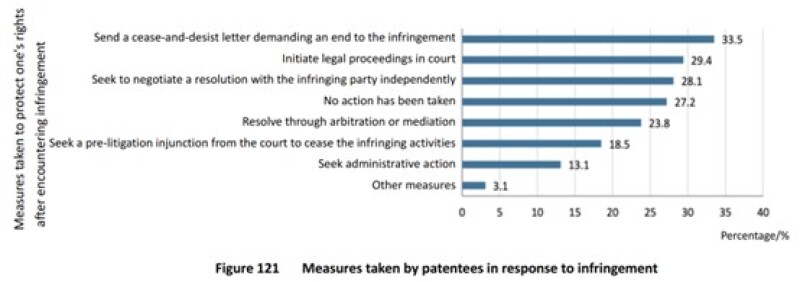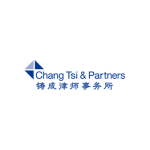Patent protection in China operates on a dual-track system, consisting of judicial protection and administrative protection.
Judicial protection refers to people's courts at all levels accepting, hearing, and adjudicating patent-related litigation, to combat infringement and safeguard the interests of patent rights holders, which is a model widely recognised by all countries.
Administrative patent protection relies on administrative law enforcement departments such as the China National Intellectual Property Administration (CNIPA) to file cases and investigate and handle infringement acts. As a public means of correcting social behaviour, administrative patent protection possesses the basic characteristics of being rapid and simple, prioritising efficiency, and having low costs.
To enhance the influence of administrative patent protection, the CNIPA issued the Administrative Adjudication Measures for Major Patent Infringement Disputes in 2021, stipulating that in cases of significant nationwide impact, rights holders can directly request the CNIPA to handle the matter.
In November 2021, the German company Boehringer Ingelheim initiated an administrative adjudication of a patent infringement dispute against YiChang HEC ChangJiang Pharmaceutical Co., Ltd. with the CNIPA. In July 2022, the CNIPA issued an injunction against YiChang HEC ChangJiang Pharmaceutical Co., Ltd. The injunction was issued within a mere eight months from application to issuance.
There has been a significant increase in administrative patent protection cases in China. According to the 2023 Statistics of Administrative Cases of Patent Infringement Disputes released by the CNIPA, 67,000 administrative cases of patent infringement disputes were concluded nationwide in 2023, representing a 15% increase from the 58,000 cases concluded in 2022 as reported in the 2022 China Intellectual Property Protection Status statistics.
Thus, it can be seen that administrative protection has become an undeniable force in China's patent protection system. Unfortunately, however, many rights holders are not familiar with this system, as only 13.1% of them choose to seek administrative authorities' intervention when their patent rights are infringed, according to the CNIPA’s 2022 China Patent Survey Report.

To better inform rights holders about this system, this article focuses on introducing the rapid, robust, and cost-effective administrative patent protection system in China, and provides typical cases as examples.
1 Characteristics of China's administrative patent protection system
1.1 High efficiency in handling cases
The Administrative Measures for Patent Enforcement (Revised in 2015) issued by the State Intellectual Property Office, the forerunner of the CNIPA, sets strict time limits for the filing, service, and conclusion of administrative adjudication of patent infringement disputes.
For example, the administrative authority shall file the case or decide not to accept it within five working days from the date of receiving the request. The request document shall be served to the requested party within five working days after the case is filed. The case shall be concluded within three months after it is filed, and for complex cases, the period may be extended to four months. This period does not include the time during which the case is suspended due to patent invalidation proceedings.
Based on the author’s experience, when the administrative authority serves the documents to the requested party, they can simultaneously conduct on-site inspections and evidence collection. In other words, within five working days after filing the case, the administrative authority can seize infringing products and account books on site. This is very rapid in combating infringement and facilitates the collection of evidence by rights holders. Furthermore, due to the three-month time limit for handling cases, the administrative authority is more proactive in handling infringement disputes and making administrative decisions within the prescribed timeframe.
1.2 Strong enforcement capability
Due to the time limits at various stages, the administrative authority exhibits strong enforcement capability in handling infringements. Once the administrative authority preliminarily determines infringement after reviewing the case materials, it promptly files the case, serves the documents, and seizes the infringing products. Furthermore, upon the administrative authority's determination of infringement, an injunction is issued, requiring the infringer to cease infringement and destroy any infringing products, proprietary equipment, and moulds.
Although the infringer has the right to challenge the administrative decision on infringement through administrative review or administrative litigation, the enforcement of the injunction is not suspended during the period of administrative review and administrative litigation. Therefore, once the administrative authority issues an injunction, the infringer must cease infringement, or else the administrative authority can use its administrative power to compel compliance. If the infringer does not file a lawsuit within the prescribed period, the administrative authority can also apply to the court for enforcement of the injunction.
Therefore, the enforcement capability in patent infringement disputes is robust, and once infringement is established, it will exert significant pressure on the infringer.
1.3 Low cost
Firstly, there is no need to pay administrative fees for patent infringement dispute administrative adjudication, which can save official fees. Secondly, the cases in administrative adjudication of patent infringement have a short duration and simple procedures, leading to significantly reduced legal fees compared with litigation proceedings.
Therefore, the overall cost of administrative adjudication of patent infringement disputes is significantly lower than the costs of initiating litigation in court.
1.4 High recognition
Once the infringing products are determined by the administrative authority, the rights holder can use this administrative decision as a basis to lodge complaints against the infringing products with e-commerce platforms. Generally, e-commerce platforms have a high degree of recognition for administrative decisions and will promptly remove links to infringing products. The rights holder can also submit the administrative decision to customs and request customs to seize infringing products in import and export by filing a record with customs.
Of course, the rights holder can also use this infringement decision as a basis to submit requests to other administrative authorities and courts for recognition of the infringement. Although other administrative authorities and courts make independent judgments on infringement, the decision has a strong positive impact on the recognition of infringement by other administrative authorities and courts.
2 Key points to obtain an administrative injunction
2.1 Relatively simple and understandable patents
Unlike the courts, administrative authorities are more cautious in filing cases. Administrative authorities only file cases when they believe there is a possibility of infringement. However, administrative authorities handle fewer patent cases, and the personnel involved may not possess relevant professional knowledge. Therefore, if a patent is overly complex, the administrative authorities may have difficulty understanding it in a short period and may be unlikely to file the case. For complex patents, lawyers may need to spend a significant amount of time explaining the patent to the administrative authorities or request certification from an authoritative third-party institution.
Therefore, for design patents, utility models, and simple invention patents that are easy to understand, it is easier for administrative authorities to comprehend and file the case. In administrative protection, it is recommended to prioritise the use of these types of patents to prevent infringement.
If it is necessary to use a complex patent, it is important to explain the principles of the patent to the administrative authorities in a clear and understandable manner, and provide a report from a third-party certification institution.
2.2 Submitting concrete evidence of infringement to the administrative authorities
As mentioned earlier, administrative authorities exercise a cautious approach when filing cases. The filing of a case involves approval at various levels within the local intellectual property office and signifies the need to address the existence of infringement.
In practice, the actual location of many infringers may not correspond to their registered address. If the administrative authorities fail to complete the service of process and seizure within the specified timeframe, the case may be revoked.
In light of the above, for rights holders, it is essential to thoroughly investigate the actual location of the infringer and the infringing products in advance, and compile this information into evidence in the form of photographs, written documentation, recordings, etc., to be submitted to the administrative authorities. It is preferable for this evidence to be obtained with the certification of a notary public. By following these procedures, the administrative authorities can be assured of completing on-site service of process and seizure, thereby considering the filing of the case.
3 Typical cases in China's administrative patent protection system
3.1 A typical design patent case
A factory was producing a large quantity of infringing products and supplying them for sale on numerous e-commerce platforms, causing significant damage to the client's market share. Pursuing patent litigation would have required a substantial amount of time and money, and may not have promptly halted the infringement. Additionally, due to the low unit price of the products, it would have been challenging to obtain significant damages through litigation. After introducing the client to the administrative patent protection system, it entrusted Chang Tsi & Partners to initiate an administrative adjudication of the patent infringement dispute with the administrative authorities.
After analysing the case, Chang Tsi & Partners first developed an investigation plan, arranged for investigators to contact the target factory, and visited the factory to understand the scale of the infringement and obtain infringing products. The investigation results revealed that the factory in question was very cunning; its actual location was not at the registered address, and the factory entrance had no signage, so the infringing products were being manufactured in a highly covert manner. This added difficulty for the administrative authorities in addressing the infringement target.
And due to the difference between the client's patent and the infringing products, the administrative authorities were initially unwilling to file the case. However, after providing numerous judicial precedents and discussions, Chang Tsi & Partners eventually persuaded the administrative authorities to agree to file the case.
Nevertheless, during the first visit to the site, the administrative authorities were unable to enter the factory gates. Even after using administrative means to gain entry, they were unable to locate the infringing items. Consequently, during the second visit to the site, Chang Tsi & Partners arranged for investigators to accompany the administrative authorities. Under the guidance of the investigators, the administrative authorities successfully located the infringing factory and seized thousands of infringing products on the spot.
In the end, the administrative patent adjudication was completed within two months, resulting in the destruction of all infringing products and moulds at the target factory. Subsequently, the infringing products on e-commerce platforms also disappeared entirely. In a relatively short time and at a low cost, Chang Tsi & Partners successfully helped the client to stop the infringement.
3.2 A typical utility patent case
This is Chang Tsi & Partners’ latest patent administrative protection case.
On March 6 2024, a client entrusted the firm to file a patent administrative complaint against a target company. To fix the evidence, Chang Tsi & Partners immediately arranged for notarised deposition of the infringing web pages of the target company and its affiliates, and purchased the infringing products from the target company's online store in a notarised manner. However, as the investigation progressed, Chang Tsi & Partners realised that the target company was not the production factory of the infringing products. Therefore, an investigator and a notary were dispatched to the production factory to take evidence on March 14 and obtained evidence of infringement from the production factory.
After thorough preparation of a patent infringement comparison table and the relevant infringement evidence materials, Chang Tsi & Partners formally filed a patent infringement dispute administrative adjudication with the administrative authority on March 21 against the four target companies. After that, the administrative authorities filed a case on March 25 and carried out a joint action on March 27, going to the four companies to seize the infringing products simultaneously. The joint action seized thousands of infringing products, while all infringing links on the e-commerce platform were removed.
Efficient communication with the administrative authorities was maintained during a very short period, convincing them of the existence of the infringement, which allowed the administrative authorities to stop the infringement by very rapid means.
4 Summary
When rights holders are facing a situation where infringing products are encroaching on their market share and urgently require an injunction, they may consider the efficient, strong enforcement, and cost-effective administrative adjudication of patent infringement disputes. However, unlike court filings, the administrative adjudication of patent infringement disputes has a higher standard for filing cases. Rights holders need to conduct investigations on the infringers, obtain concrete evidence of infringement, and provide a detailed explanation of the patent to persuade the administrative authorities of the existence of infringement.
After obtaining an administrative decision on infringement, the rights holder can use this decision to file complaints with e-commerce platforms to remove infringing links. They can also use the decision to file with customs, requesting the seizure of infringing products in import and export. Furthermore, the rights holder can submit the decision to other administrative authorities and courts to influence them in making additional determinations of infringement and judgments.












